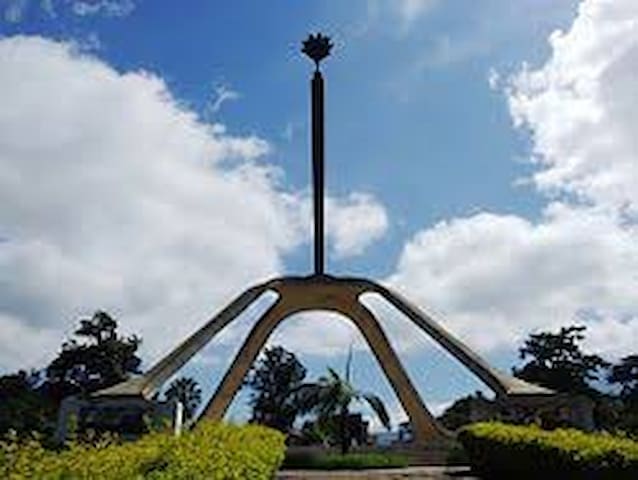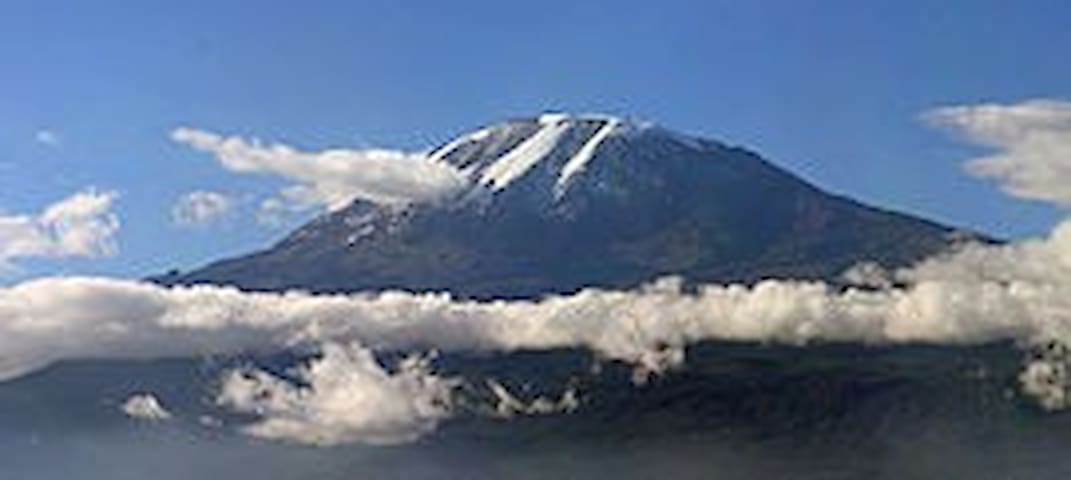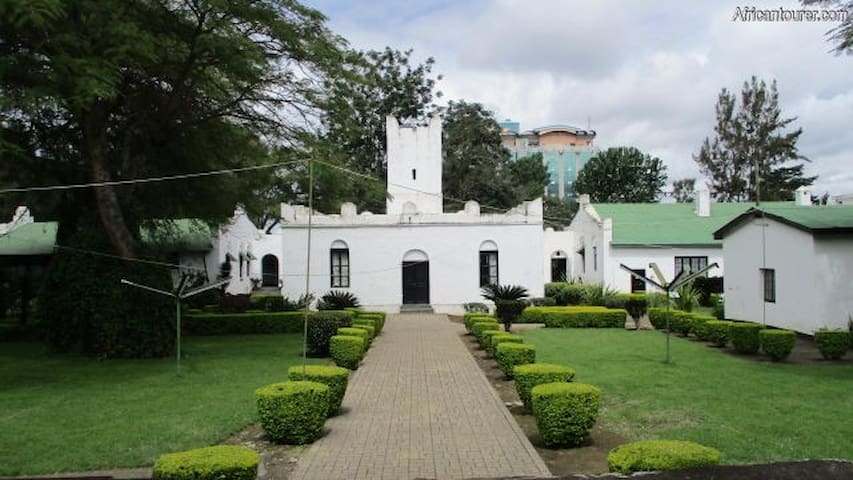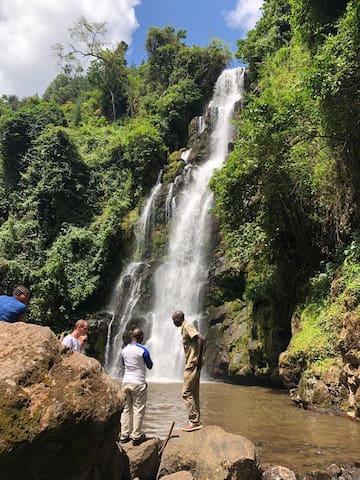sightseeing
This is a volcanic mountain associated with some small hills around it. Most of these hills provide a good viewpoint, good places for taking photos. but also they are well-recognized waterfalls. At culture home, we provide a free guide but you have to pay for transport and entrance fee which is not expensive.
https://en.wikipedia.org/wiki/Mount_Meru_(Tanzania)
19 người dân địa phương đề xuất
Mount Meru
This is a volcanic mountain associated with some small hills around it. Most of these hills provide a good viewpoint, good places for taking photos. but also they are well-recognized waterfalls. At culture home, we provide a free guide but you have to pay for transport and entrance fee which is not expensive.
https://en.wikipedia.org/wiki/Mount_Meru_(Tanzania)
Just a 20-minute drive away from Arusha, in the shadow of Mount Meru, lays a crater lake. The Meru tribe of the area named it Duluti. Lake Duluti is formed inside a volcanic crater and has water throughout the year, mainly from groundwater and seasonal rainfall. The crater is a subsidiary vent to Mount Meru (4566m) that towers over the lake.
Lake Duluti Road
Lake Duluti RoadJust a 20-minute drive away from Arusha, in the shadow of Mount Meru, lays a crater lake. The Meru tribe of the area named it Duluti. Lake Duluti is formed inside a volcanic crater and has water throughout the year, mainly from groundwater and seasonal rainfall. The crater is a subsidiary vent to Mount Meru (4566m) that towers over the lake.
The crater, classified as UNESCO World Heritage, is a caldera, i. e. an old crater, perhaps as high as today's Kilimanjaro, but collapsed about 2,5 million years ago, after the entire interior, driven by burst gases, was emptied and spilled onto the plains. surrounding, in particular the upper layer of the Serengeti. It is said that fumaroles are still sometimes present above the center of the crater. The Ngorongoro crater (one of the 115 conservation zone) is today the place where the density of animals is the most important in Africa. For mystics, it is a calyx where nature shows God's presence reflecting its splendor.
https://en.wikipedia.org/wiki/Ngorongoro_Conservation_Area
45 người dân địa phương đề xuất
Ngorongoro Crater
The crater, classified as UNESCO World Heritage, is a caldera, i. e. an old crater, perhaps as high as today's Kilimanjaro, but collapsed about 2,5 million years ago, after the entire interior, driven by burst gases, was emptied and spilled onto the plains. surrounding, in particular the upper layer of the Serengeti. It is said that fumaroles are still sometimes present above the center of the crater. The Ngorongoro crater (one of the 115 conservation zone) is today the place where the density of animals is the most important in Africa. For mystics, it is a calyx where nature shows God's presence reflecting its splendor.
https://en.wikipedia.org/wiki/Ngorongoro_Conservation_Area
Arusha City Centre
a cool town full of everything, local markets, supermarkets, and restaurants
With one day in Arusha you can cover key sites, but coordinating transport and activities takes up valuable sightseeing time. Choose a private tour to see and do more in the city, from browsing shops at the Arusha Central Market to checking out tribal traditions in the Cultural Heritage Centre. Door-to-door service means you won’t need to fight Arusha traffic, leaving you free to focus on exploring. Private tour ensures individualized attention from the guide Try local flavors with a provided lunch Tour the Cultural Heritage Centre, admission included Convenient pickup and drop-off at your accommodations
Read more about 24 Hours in Arusha—Arusha Museum, Cultural Heritage, Maasai Market, Shanga 2020 - https://www.viator.com/tours/Arusha/Arusha-City-Tours-KartingshangaArusha-museumCultural-heritageMaasai-Market/d5593-120546P14?mcid=56757
16 người dân địa phương đề xuất
Cultural Heritage Art Gallery & Shops
Sokoine RoadWith one day in Arusha you can cover key sites, but coordinating transport and activities takes up valuable sightseeing time. Choose a private tour to see and do more in the city, from browsing shops at the Arusha Central Market to checking out tribal traditions in the Cultural Heritage Centre. Door-to-door service means you won’t need to fight Arusha traffic, leaving you free to focus on exploring. Private tour ensures individualized attention from the guide Try local flavors with a provided lunch Tour the Cultural Heritage Centre, admission included Convenient pickup and drop-off at your accommodations
Read more about 24 Hours in Arusha—Arusha Museum, Cultural Heritage, Maasai Market, Shanga 2020 - https://www.viator.com/tours/Arusha/Arusha-City-Tours-KartingshangaArusha-museumCultural-heritageMaasai-Market/d5593-120546P14?mcid=56757
The snake park is a special treasure of Arusha, a wonderful source of enjoyment and relaxation for locals and foreign visitors.
The snake park is located 25km west of Arusha on the route to the Serengeti and Ngorongoro crater.
The snake park provides various activities, take a guided tour and learn about some of the most dangerous snakes in the world, from the Black and Green Mamba, Egyptian Cobra, Puff Adders and many more. Capture your special moment and hold a real live snake. Check out the 3m plus crocodiles at feeding time and touch a baby crocodile.
15 người dân địa phương đề xuất
Vườn rắn Meserani
The snake park is a special treasure of Arusha, a wonderful source of enjoyment and relaxation for locals and foreign visitors.
The snake park is located 25km west of Arusha on the route to the Serengeti and Ngorongoro crater.
The snake park provides various activities, take a guided tour and learn about some of the most dangerous snakes in the world, from the Black and Green Mamba, Egyptian Cobra, Puff Adders and many more. Capture your special moment and hold a real live snake. Check out the 3m plus crocodiles at feeding time and touch a baby crocodile.
a dormant volcano in Tanzania. It has three volcanic cones: Kibo, Mawenzi, and Shira. It is the highest mountain in Africa and the highest single free-standing mountain in the world: 5,895 meters (19,341 ft) above sea level and about 4,900 meters (16,100 ft) above its plateau base.
https://en.wikipedia.org/wiki/Mount_Kilimanjaro
41 người dân địa phương đề xuất
Mount Kilimanjaro
a dormant volcano in Tanzania. It has three volcanic cones: Kibo, Mawenzi, and Shira. It is the highest mountain in Africa and the highest single free-standing mountain in the world: 5,895 meters (19,341 ft) above sea level and about 4,900 meters (16,100 ft) above its plateau base.
https://en.wikipedia.org/wiki/Mount_Kilimanjaro
This is a beautiful little waterfall, with its principal advantage being its proximity to Arusha. The journey from Arusha is just 7km and takes only 15 minutes. Having parked, there is a short walk that involves some steep ground and some clambering, but is quite manageable, even for young children.
7 người dân địa phương đề xuất
Mount meru waterfalls
Sekei RoadThis is a beautiful little waterfall, with its principal advantage being its proximity to Arusha. The journey from Arusha is just 7km and takes only 15 minutes. Having parked, there is a short walk that involves some steep ground and some clambering, but is quite manageable, even for young children.
The Boma natural history museum of is a compound that showcases the natural history, wildlife, culture and artifacts of the Arusha region - Tanzania. It is housed inside what was an old German military outpost and has three separate buildings that are open to the public (the rest being offices), an outdoor mini botanical garden and an outdoor art and crafts gallery.
One of the three buildings are for wildlife, the other for history of the region's events and the third for archaeological history. The museum is part of the national museums of Tanzania, that also includes the Dar es Salaam museum, Sukuma museum, Mwalimu Nyerere museum and the Makumbusho village museum.Some of the things that can be found at the museum include:
Artifacts from excavations of neighbouring areas such as Olduvai Gorge and other dead wildlife
A history of the region of Arusha and its people
A wildlife section with photographs and taxidermy
An arts gallery that displays the work of over 12 of the best local artists
Art and crafts lessons from local including painting, drum making etc
A mini botanical garden
A small pond with some of the local freshwater fish
A mini serpentarium
A mini zoo with some of the region's rare animals such as an eagle
A insect section detailing some of the diseases and problems they cause
A taxidermy office
Photography of some of the local tribes
A history of the place
The Original Boma was built from 1899 to 1900 to be a German military outpost for the region of Arusha. This was to keep a closer eye on the Meru and Arusha tribes, whose opposition they had just defeated in the years 1897 and 1898. It also served as an administrative office and residence for other officials of the colonial rule.
The defeated warriors were forced to dig out stone with their spears and ferry them to the construction site using their shields, working at least seven hours each day to build the fort. The tribe's women and children were forced to bring banana fiber for thatching while the elderly had to create the mortar for joining the stone from wet mud.
The final structure was a walled rectangular compound with a trench about 6 feet deep and a barbed wire fence making its outside perimeter. Inside the compound were several buildings, whereas outside and next to it were a coffee plantation and a kitchen garden.
It was the first modern structure in the whole region and a security stronghold, something that brought more people to the area seeking employment and trade opportunities. When the British took over from the Germans after the first world war, its use as a fort continued, with the front two buildings being used by government officers.
In 1979, it was turned into a natural history museum by the then independent government of Tanzania. Since then several sections have been added, including the mini botanical garden, a small aquarium - pond, an arts gallery for the local artists that also provides lessons, a wildlife section, a history section and an artifacts section.
Throughout this whole period, there was a road that approached the compound from the lower south that was lined with trees on either side. This road still exists today, with some of the original trees and has taken the compound's name - Boma road.
What to do there?
Learn about the history of the region of arusha from as early as the late 19th century up until the mid 20th century (the declaration museum has more of 20th century history). You can also learn a lot more about animals and insects that can be found in the area's national parks as well as common homes.
There also are a lot of artifacts from excavations in the neighboring areas, like the famous zinjathropus skull from Olduvai gorge (a copy) and life like sculptures of early man for you to view. At the museum's rear is a gallery where some of the local artists showcase as well as create their work.
If you are lucky, you may catch one of them doing their thing or even create some art of your own under their guidance for a small fee. The art section also provides drum making lessons as well as art for sale. Don't forget to check out the real life eagle, fish and tortoises.
Location of Boma natural history museum
The Boma Natural history museum of Arusha is located at the uphill end of Boma rd. amidst a tranquil, tree filled neighbourhood of the city of Arusha - Tanzania. It also is well inside the CBD and within close proximity to offices, hotels, restaurants, tour and travel agents and shops. It also lies in the riparian zone of the Themi river, that flows from the slopes of mt. Meru, through the city and out from its southern suburbs. For more information about its location, please see the map below (click to start).
How to get there?
With private transport, you would first need to get to the clock tower, a famous monument of the city, then from there head uphill (north). The museum is the located at the end of the northbound - Boma road that was named after it.
If you are using public transport then you would need to find minibusses headed to the clock tower or Arusha hotel area and get off at the clock tower stop. From there a simple ten minutes walk uphill should get you to the museum.
10 người dân địa phương đề xuất
Arusha National Natural History Museum
The Boma natural history museum of is a compound that showcases the natural history, wildlife, culture and artifacts of the Arusha region - Tanzania. It is housed inside what was an old German military outpost and has three separate buildings that are open to the public (the rest being offices), an outdoor mini botanical garden and an outdoor art and crafts gallery.
One of the three buildings are for wildlife, the other for history of the region's events and the third for archaeological history. The museum is part of the national museums of Tanzania, that also includes the Dar es Salaam museum, Sukuma museum, Mwalimu Nyerere museum and the Makumbusho village museum.Some of the things that can be found at the museum include:
Artifacts from excavations of neighbouring areas such as Olduvai Gorge and other dead wildlife
A history of the region of Arusha and its people
A wildlife section with photographs and taxidermy
An arts gallery that displays the work of over 12 of the best local artists
Art and crafts lessons from local including painting, drum making etc
A mini botanical garden
A small pond with some of the local freshwater fish
A mini serpentarium
A mini zoo with some of the region's rare animals such as an eagle
A insect section detailing some of the diseases and problems they cause
A taxidermy office
Photography of some of the local tribes
A history of the place
The Original Boma was built from 1899 to 1900 to be a German military outpost for the region of Arusha. This was to keep a closer eye on the Meru and Arusha tribes, whose opposition they had just defeated in the years 1897 and 1898. It also served as an administrative office and residence for other officials of the colonial rule.
The defeated warriors were forced to dig out stone with their spears and ferry them to the construction site using their shields, working at least seven hours each day to build the fort. The tribe's women and children were forced to bring banana fiber for thatching while the elderly had to create the mortar for joining the stone from wet mud.
The final structure was a walled rectangular compound with a trench about 6 feet deep and a barbed wire fence making its outside perimeter. Inside the compound were several buildings, whereas outside and next to it were a coffee plantation and a kitchen garden.
It was the first modern structure in the whole region and a security stronghold, something that brought more people to the area seeking employment and trade opportunities. When the British took over from the Germans after the first world war, its use as a fort continued, with the front two buildings being used by government officers.
In 1979, it was turned into a natural history museum by the then independent government of Tanzania. Since then several sections have been added, including the mini botanical garden, a small aquarium - pond, an arts gallery for the local artists that also provides lessons, a wildlife section, a history section and an artifacts section.
Throughout this whole period, there was a road that approached the compound from the lower south that was lined with trees on either side. This road still exists today, with some of the original trees and has taken the compound's name - Boma road.
What to do there?
Learn about the history of the region of arusha from as early as the late 19th century up until the mid 20th century (the declaration museum has more of 20th century history). You can also learn a lot more about animals and insects that can be found in the area's national parks as well as common homes.
There also are a lot of artifacts from excavations in the neighboring areas, like the famous zinjathropus skull from Olduvai gorge (a copy) and life like sculptures of early man for you to view. At the museum's rear is a gallery where some of the local artists showcase as well as create their work.
If you are lucky, you may catch one of them doing their thing or even create some art of your own under their guidance for a small fee. The art section also provides drum making lessons as well as art for sale. Don't forget to check out the real life eagle, fish and tortoises.
Location of Boma natural history museum
The Boma Natural history museum of Arusha is located at the uphill end of Boma rd. amidst a tranquil, tree filled neighbourhood of the city of Arusha - Tanzania. It also is well inside the CBD and within close proximity to offices, hotels, restaurants, tour and travel agents and shops. It also lies in the riparian zone of the Themi river, that flows from the slopes of mt. Meru, through the city and out from its southern suburbs. For more information about its location, please see the map below (click to start).
How to get there?
With private transport, you would first need to get to the clock tower, a famous monument of the city, then from there head uphill (north). The museum is the located at the end of the northbound - Boma road that was named after it.
If you are using public transport then you would need to find minibusses headed to the clock tower or Arusha hotel area and get off at the clock tower stop. From there a simple ten minutes walk uphill should get you to the museum.
Take a walk through Marangu coffee farms and visit a local home where you will learn ... the traditional blacksmiths, visiting nearby caves, waterfalls, coffee plantation areas ... It takes 20 minutes hike to Kinukamori from Marangu starting point.
Marangu waterfall, Coffee,cave and hiking
Take a walk through Marangu coffee farms and visit a local home where you will learn ... the traditional blacksmiths, visiting nearby caves, waterfalls, coffee plantation areas ... It takes 20 minutes hike to Kinukamori from Marangu starting point.
here all culture of the Meru tribe is well elaborated, never hesitate to get in here
Tengeru Cultural Tourism Programme
here all culture of the Meru tribe is well elaborated, never hesitate to get in here
German Boma
A historic place in Arusha mostly for the German colonization in Tanzania
Food scene
Vions Lounge
fast food, delicious with a nice African music
Nice social hall for the conference and other social activities such as ceremonial activities.
At Piazza hall offers restaurant service of which staying at our apartment you can opt for their services
Piazza Hall
Nice social hall for the conference and other social activities such as ceremonial activities.
At Piazza hall offers restaurant service of which staying at our apartment you can opt for their services
Neighborhoods
Something to put in mind about Arusha, according to research Arusha is half countryside and half urban.
this characteristic stands Arusha to be unique as the flow of products from the countryside is much smooth and it's vice versa due to this characteristics
book our itinerary for the country side exploration
Arusha Urban
Something to put in mind about Arusha, according to research Arusha is half countryside and half urban.
this characteristic stands Arusha to be unique as the flow of products from the countryside is much smooth and it's vice versa due to this characteristics
book our itinerary for the country side exploration
Lời khuyên du lịch trong thành phố
Cách đi lại
Walking around in Tanzania is safe, Tanzanian are friendly
Arusha roads are not congested,, hence public transport is easy and fast. Arusha has an average of 20 degrees Celcius centigrade of temperature.
shopping most of the places are served locally and require cash.
while at Arusha you can have access to traditional coffee processing from Meru and Chagga tribes
lastly, we provide a home visit to experience African culture






